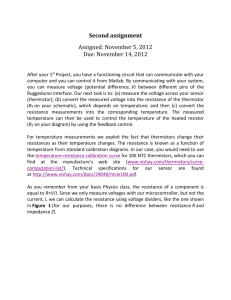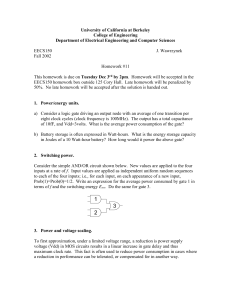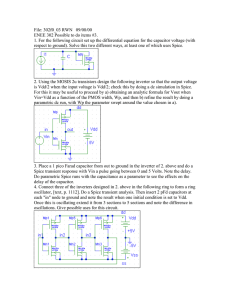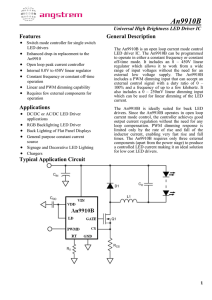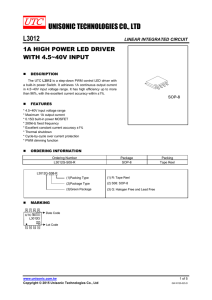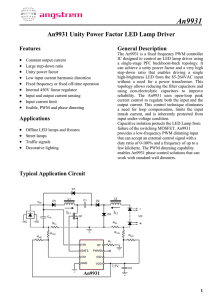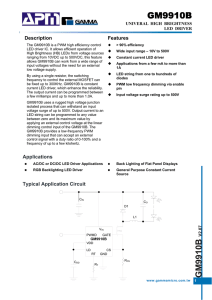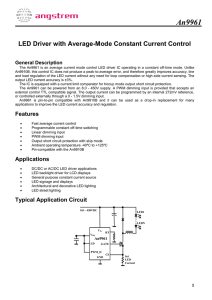DrGaNPLUS Development Board
advertisement
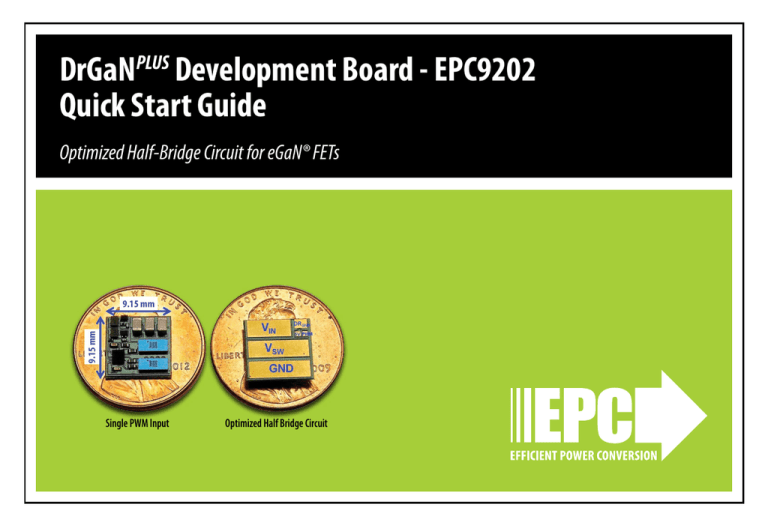
DrGaNPLUS Development Board - EPC9202 Quick Start Guide Optimized Half-Bridge Circuit for eGaN® FETs Single PWM Input Optimized Half Bridge Circuit DESCRIPTION www.epc-co.com This development board, measuring 0.36” x 0.36”, contains two enhancement mode (eGaN®) field effect transistors (FETs) arranged in a half bridge configuration with an onboard Texas Instruments LM5113 gate drive and is driven by a single PWM input. The purpose of these development boards is to simplify the evaluation process by optimizing the layout and including all the critical components on a single board that can be easily connected into any existing converter. A complete block diagram of the circuit is given in Figure 1. For more information on EPC’s family of eGaN FETs, please refer to the datasheets available from EPC at www.epc-co.com. The datasheet should be read in conjunction with this quick start guide Table 1: Performance Summary (TA = 25°C) SYMBOL PARAMETER VDD Gate Drive Input Supply Range VIN Bus Input Voltage Range VOUT Switch Node Output Voltage IOUT Switch Node Output Current VPWM PWM Logic Input Voltage Threshold CONDITIONS MIN MAX UNITS 4.5 5 V 70* V 100 V 10* A Input ‘High’ 3.5 6 V Input ‘Low’ 0 1.5 V Minimum ‘High’ State Input Pulse Width VPWM rise and fall time < 10ns 60 ns Minimum ‘Low’ State Input Pulse Width VPWM rise and fall time < 10ns 200 # ns * Assumes inductive load, maximum current depends on die temperature – actual maximum current with be subject to switching frequency, bus voltage and thermals. # Limited by time needed to ‘refresh’ high side bootstrap supply voltage. VDD Half-Bridge with High Frequency Input Capacitors Gate Drive Supply VIN PWM Input Logic and Dead-time Adjust LM5113 Gate Driver OUT Figure 1: Block Diagram of Development Board THERMAL CONSIDERATIONS The development board is intended for bench evaluation with low ambient temperature and convection cooling. The addition of heat-sinking and forced air cooling can significantly increase the current rating of these devices, but care must be taken to not exceed the absolute maximum die temperature of 125°C. NOTE. The development board does not have any current or thermal protection on board. TYPICAL PERFORMANCE www.epc-co.com EPC9202 97% fsw = 300 kHz 96.5% fsw = 500 kHz 96% Efficiency 95.5% 95% 94.5% 94% 93.5% 93% 92.5% Figure 2: Typical switch node voltage rising waveform for VIN = 48 V to VOUT =12 V, IOUT =10 A, fsw=300 kHz buck converter 0 1 2 3 4 5 6 7 8 Ourput Current (A) 9 10 11 12 Figure 3: Typical efficiency for VIN=48 V to VOUT = 12 V buck converter with 100 V devices (Inductor: Coilcraft SER1390-103MLB) 13 DESIGN CONSIDERATIONS www.epc-co.com To improve the electrical and thermal performance of the DrGaNPLUS development board some design considerations are recommended: 1. Large copper planes should be connected to the development board to improve thermal performance as shown in figures 4 through 6. If filled vias are used in the board design, thermal vias should be placed under the device as shown in figure 4 to better distribute heat through buried inner layers. For a design without filled vias, thermal vias should be located outside of the development board as shown in figure 6. Also, for a design without filled vias, the vias to make the VDD connection should be tented and located outside of the VDD pad. 2. To reduce conduction losses, the inductor and output capacitors should be located in close proximity to the development board. 3. The smaller IC ground connection (pin 6 in mechanical drawings), should be isolated from the power ground connection (pin 3 in mechanical drawings). 4. If additional input filter capacitance is required, it can be placed outside the module. Due to the internal on-board input capacitance, minimizing the distance of the additional input capacitors to the development board, while preferred, is not a design requirement. Figure 4: Top layer layout with filled thermal vias Figure 5: Bottom layer layout Figure 6: Top layer layout without filled thermal vias MECHANICAL DATA www.epc-co.com J B N K C F D A L G P M E O I H Pin 1: Input Voltage, VIN 6 1 Pin 2: Switching Node, VSW Pin 3: Power Ground, PGND 4 5 Pin 4: PWM Input, PWM 2 Pin 5: Driver Voltage, VDD Pin 6: IC Ground, AGND 3 A B C D E F G H I J K L M N O P 9.15 mm 9.15 mm 2.5 mm 2.5 mm 2.6 mm 0.525 mm 0.525 mm 8.475 mm 6.15 mm 0.525 mm 0.2 mm 0.475 mm 0.45 mm 1.8 mm 1.4 mm 0.8 mm Table 2 : Bill of Materials MECHANICAL DATA www.epc-co.com Item Board Qty Part Description Manufacturer / Part # Component 1 3 C11, C22, C23 Capacitor, 1uF, 20%, 100V, X7S, 0805 TDK, C2012X7S2A105M125AB 2 2 Q1, Q2 100 V 25 A eGaN FET EPC, EPC2001 3 4 R19, R20, R23, R24 Resistor, 0 Ohm, 1/16W Stackpole, RMCF0402ZT0R00TR 4 1 C9 Capacitor, 0.1uF, 10%, 25V, X5R TDK, C1005X5R1E104K050BC 5 1 C19 Capacitor, 1uF, 10%, 16V, X5R TDK, C1005X5R1C105K050BC 6 1 U2 I.C., Gate driver Texas Instruments, LM5113 7 2 D1, D2 Diode Schottky 40 V 0.12A SOD882 NXP, BAS40L,315 8 1 U4 IC GATE AND UHS 2-INP 6-MICROPAK Fairchild, NC7SZ08L6X 9 1 U1 IC GATE NAND UHS 2-INP 6MICROPAK Fairchild, NC7SZ00L6X 10 1 R1 Resistor, 10K Ohm 1/20W 1% 0201 Stackpole, RMCF0201FT10K0 11 2 C6, C7 Capacitor, CER 100pF 25V 5% NP0 0201 TDK, C0603C0G1E101J030BA 12 1 R4 Resistor, 0 OHM 1/20W 0201 SMD Panasonic, ERJ-1GN0R00C 13 1 R5 Resistor, 56 Ohm 1/20W 1% 0201 SMD Panasonic, ERJ-1GEF56R0C 1 2 3 4 5 6 VCC A VIN A C11 C22 C23 PWM R1 U1 A VDD U2 C9 B G ND R19 Y Q1 VG 1 VA R23 NC 7SZ00L6X B U4 A R20 VDD B C19 LM5113TM HIN D1 Y NC 7SZ08L6X C Q2 R24 B G ND VG 2 R4 C C6 D2 L IN R5 C7 D Development Board Schematic Rev 0 1 2 3 4 5 6 D

